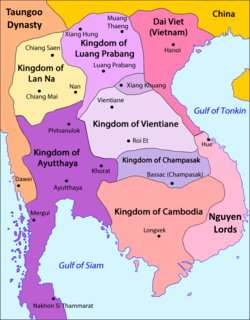Muang Phuan
| Principality of Phuan | ||||||||||
|
||||||||||
| Capital | Xieng Khouang | |||||||||
| Languages | Lao | |||||||||
| Religion | Buddhism | |||||||||
| Government | Monarchy | |||||||||
| History | ||||||||||
| • | Lan Xang divided | 1707 | ||||||||
| • | French Protectorate of Laos | 1899 | ||||||||
|
||||||||||
| Today part of |
|
|||||||||
Muang Phuan (Xieng Khouang, or Trấn Ninh (historical Vietnamese name of the province)) was a historical principality on the Xiangkhoang Plateau, which constitutes the modern territory of Xiangkhouang Province, Laos. Among the Lao, Phuan, and Thai muang has a dual meaning of “city” or more broadly “country of” and xieng means “walled.” The two terms were often used together for major city states under the Southeast Asian mandala model, thus Muang Xieng Khouang would be transcribed as the “Walled City/Country of the Phuan” (Khouang is a French corruption of Phuan).
The Xiangkhouang Plateau is semi-arid but has important iron ore resources and has been inhabited since the Bronze Age (the Plain of Jars is an important UNESCO archeological site). The region is an important area for trade as it occupies the major passes along the Annamite Cordillera to access Vietnam and the coast.
The Tai Phuan or Phuan people are a Buddhist Tai-Lao ethnic group that migrated to the area which is now Laos during the 13th century. According to legend the Phuan people were led by Chet Chuong, the second son of Khun Borom who founded the city-state of Muang Phuan. In the mid-14th century Muang Phuan was incorporated into the Lan Xang Kingdom under King Fa Ngum. Under the Mandala model, cities or even kingdoms would enter into tributary relationships with their neighbors depending on regional power; in exchange the tribute would maintain local autonomy. It was not uncommon to pay tribute to more than one power even concurrently. In 1434, Muang Phuan entered into a tributary relationship with the Dai Viet. However, by 1478 the Dai Viet attempted to annex Muang Phuan as a prefecture, which contributed to war between Lan Xang and the Dai Viet. The Dai Viet army ultimately withdrew during that conflict, and Muang Phuan returned as a tributary to Lan Xang. However, the peace was short-lived and by 1531 Muang Phuan rebelled against King Photisarath who put down the rebellion after two years. Throughout the 16th and 17th century Muang Phuan remained part of Lan Xang.
...
Wikipedia

